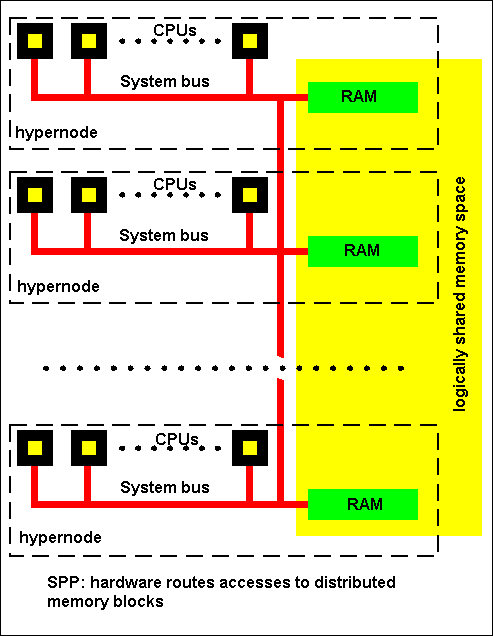- SMP (Symmetric Multiprocessing).
Design also known as "tightly coupled" or "shared everything".
- Multiple processors share RAM and system bus
PROS
- Simple system and application programming.
- The single memory space lets a threads OS distribute its tasks among various processors.
- A High Level Optimizer (HLO) may easily produce parallel code, starting from "simple" source code, without message-passing instructions.
- Adding more processors, memory traffic increas, until reaching the saturation of the bus (some bus traffic may however be reduced by adding cache memory to every processor).

- MPP (Massively Parallel Processing).
Design also known as "loosely coupled" or "shared nothing".
- RAM is distributed among the processors
PROS
- Avoid memory-bus bottleneck. The MPP systems reduce bus traffic because each section of memory sees only those accesses that are bound for it, rather than every memory access, as in SMP systems.
- Allow very large parallelization. U.S. Department of Energy ASCI (Accelerated Strategic Computing Initiative) uses more then 9000 Intel Pentium-Pro (P6) CPUs.
- To access the memory outside its own RAM, a processor must use a message-passing scheme, analogous to network packets.
- Programming is more difficult. You have to insert, in the source code, message-passing commands.
- The source code may become hardware-dependent; the use of PVM (Parallel Virtual Machine) public domain message-passing mechanism and the develope of a standard Message Passing Interface (MPI) may however solve this problem.
- Time delay may occur when data migrates from one processor to a distant one.

- Uses a two-tiers memory hierarchy. The first memory tier consists of a hypernode, which is, essentially, an SMP system, complete with multiple processors and their globally shared memory. Large SPP systems are build by interconnecting several hypernodes via second memory tier so that this tier appears logically as one global shared memory space to the nodes.
PROS
- Reduced bus traffic. Only updates to keep memory coherent among the nodes occur.
- Easy-to-program SMP programming model.
- Scalability similar to that of an MPP design.


